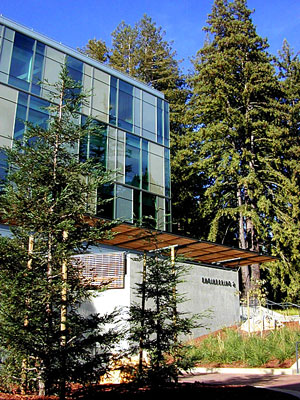UC Santa Cruz has taken another step in increasing its sustainability by obtaining its first LEED certification--the internationally recognized "green" standard for buildings.
That accomplishment feels "very good," said Jim Dunne, director of Physical Plant. Dunne was a co-manager, along with Chancellor's Undergraduate Internship Program intern Louise Huttinger, of the project that certified the Engineering 2 building.
"We actually changed the way the building operated, and the way the building occupants operated," Dunne said.
Leadership in Energy and Environmental Design (LEED) certification, developed and administered by the nonprofit U.S. Green Building Council, provides a framework for measuring and implementing building sustainability.
The LEED rating system offers four certification levels for new construction--Certified, Silver, Gold, and Platinum--that correspond to the number of credits accrued in five green design categories: sustainable sites, water efficiency, energy and atmosphere, materials and resources, and indoor environmental quality. LEED standards cover new commercial construction and major renovation projects, interiors projects, and existing building operations.
The Engineering 2 building was awarded a Silver rating. Obtaining the certification was part of a UC-wide mandate by the Office of the President, according to Dunne.
Working with every unit in Physical Plant, the Jack Baskin School of Engineering, Physical Planning & Construction, the Grounds Department, and the Purchasing Department, Dunne and Huttinger completed an 18-month review and submitted a 530-page certification document for the Engineering 2 building, which was built in 2004.
The submittal detailed every aspect of construction and operation for the building. For example, with the Grounds Department, the team inspected how rainwater leaves the site in an effort to figure out how to reduce sediment in the natural campus streams.
The team measured everything imaginable in the building to make sure they had the most efficient possible systems: Irrigation, heating and cooling, waste, lighting.
For example, they did an audit and identified stuff in the waste stream that could be recycled. Using this data, with cooperation from building occupants, they reduced the waste stream and increased recycling by 37 percent.
For Huttinger, the experience taught her "an incredible amount about the environmental aspect of buildings, but also why retrofitting is important."
"I learned a lot of things that are really complicated that you don't learn in class," Huttinger said.
Huttinger, a senior majoring in environmental studies, passed the LEED Accredited Professional exam in December, becoming likely one of only a handful of students with this certification, said Dunne.
Physical Plant custodians now clean the building with certified sustainable cleaning products, and even the floor mats are made from recycled plastic bottles.
The efforts they made to gain LEED certification have translated into a savings of 276,000 kWh of electricity and 17,000 therms of natural gas, decreasing costs by $44,000 per year, according to Dunne.
The LEED project also received points for an onsite tree re-planting program developed by the campus arborist, Roger Edburg.
Dunne and Huttinger were invited to present their project experience at the Advancement of Sustainability in Higher Education conference in Raleigh, North Carolina, in November. After the presentation, Dunne was invited to participate in a U.S. Green Building Council review team for the next LEED revision, a volume certification process for agencies with numerous buildings.
And now Physical Plant is taking what it's learned during the LEED process and applying it to other buildings on campus, said Dunne.



